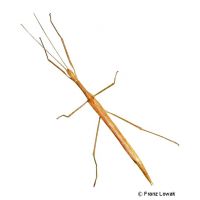Pink Winged Stick Insect (Sipyloidea sipylus)
| Pink Winged Stick Insect Sipyloidea sipylus | |
|---|---|
| Name | Pink Winged Stick Insect |
| Name Lat. | Sipyloidea sipylus |
| Family | Lonchodid Stick Insects |
| Family lat. | Lonchodidae |
| Order | Phasmids |
| Order lat. | Phasmatodea |
| Origin | Southeast Asia |
| Habitat | Forest, shrubs |
| Diet | Fresh rose-family leaves |
| Humidity | 60-80 % |
| Behavior | Peaceful, nocturnal |
| Keeping | Individual, pair, group |
| Care Level | Easy |
| Housing | Semi-humid terrarium |
| Breeding | Simple |
| Life Span | 3 months |
| Protection | No |
| Metric Units | |
| Size | 7-10 cm |
| Temperature Day | 22-25 °C |
| Temperature Night | 18-20 °C |
| Housing Size | 40 x 40 x 60 cm |
| US Units | |
| Size | 2.8"-4" |
| Temperature Day | 72-77 °F |
| Temperature Night | 64-68 °F |
| Housing Size | 15" x 15" x 25" |
Distribution and habitat
The nocturnal pink-winged stick insects are distributed from southern China and the Malay Archipelago to Australia, and in Madagascar they were probably introduced by humans. The animals live mainly on bushes and shrubs of tropical forests and also on cotton fields.
Maintenance
A terrarium of 40 x 40 x 60 cm (L x W x H) is recommended for a pair or a small group. A terrarium with a cover made of gauze or fine metal mesh is best. The terrarium should be placed in a quiet place without sunlight
They need climbing opportunities, such as cork back walls, twigs and branches, which also serve as food plants. In order to keep them fresh for a longer time, they should be served in narrow-necked, well-sealed (danger of drowning), stable containers (e.g. vase). Suitable substrate is terrarium humus or a soil-sand mixture covered with moss, which should always be kept slightly moist. Every 1-2 days, preferably in the evening, the insectarium should be finely sprayed with water inside (humidity), but a rain or mist system is better. Too high humidity and waterlogging should be avoided at all costs. Good ventilation is especially important.
| Daytime temp.: 22-25 °C | Temp. night: 18-20 °C | Humidity: 60-80 |
Although the animals are nocturnal, a light source that also produces the necessary heat is ideal. The lighting duration should be 8-12 hours, depending on the season
Diet
The food supply consists of fresh leaves of blackberry, honeysuckle (Lonicera nitida), laburnum, elderberry and ivy (Hedera helix), as well as leaves of ferns. Leaves of other roses and rose plants, such as red and hawthorn, raspberry, currant, wild rose, firethorn, etc., as well as the leaves of beech, oak, linden, hazel, eucalyptus or sweet chestnut are also accepted in different individual ways. Blackberries are ideal as food in winter, as they remain green. Spraying the forage plants allows the animals to satisfy their drinking needs. Additionally, a wick waterer is recommended. Eaten branches, dried and rotten leaves must be removed regularly
A regular and varied diet promotes the well-being of the animals.
Reproduction and breeding
Both sexes have mostly pale yellow coloration with light brown grain on the top of the body and very long antennae. The females are significantly larger than the slimmer males
They can reproduce sexually but also asexually (parthenogenesis).
The female lays eggs about 4 mm long, preferably in niches and crevices of tree bark. The incubation period is about 3 months at room temperature, and the nymphs are usually grass-green in color. The newly hatched young are about 18 mm long. After the last moult (imaginal moult) the animals can live for about 3 months.
Important
The pale pink coloration on parts of the forewings give the animals their name.
Shape and coloration of the animals remind of small, thin branches (branch mimesis)
For moulting they hang upside down in the branches or on the lattice cover and slide out of their old cover. Therefore they need at least a whole body length including legs of free space underneath.
Before purchasing, a terrarium should be prepared that meets the species specific needs. Necessary are good ventilation without drafts and devices for measuring temperature and humidity. The lighting has to correspond to the species-specific day-night rhythm and should be installed in such a way that the animals cannot injure themselves
The terrarium should be locked in such a way that neither unauthorized persons can open it nor the animals can escape. Special attention must be paid to thorough hygiene and impurities must be removed regularly
Further literature can be found in your pet store
References
Text: petdata; Image: Franz Lowak
Source: SEILER, BRADLER, KOCH (2000): Ratgeber Phasmiden, Verlag Bede; ENGELMANN & LANGE (2011): Zootierhaltung - Tiere in menschlicher Obhut: Wirbellose, Harri Deutsch Verlag
